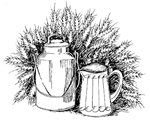
YOUR NEED FOR PROBIOTICS
Most are familiar with antibiotics and millions use them on a regular basis. Antibiotics are used to kill disease causing bacteria and their usage is effective in reducing the severity and length of illness caused by such bacteria. Unfortunately, antibiotics don’t discriminate between disease causing bacteria and friendly bacteria. Antibiotics kill both the bad guys and the good guys. When the friendly bacteria are destroyed, the door is opened for a variety of unfriendly organisms to take residence in our intestinal tract such as yeasts, fungi and other detrimental organisms.
Probiotics are friendly bacteria, also referred to as microflora. The name probiotic means “for life.” The World Health Organization (WHO) defines probiotics as “viable micro-organisms that contribute to intestinal balance and have the potential to improve the health of their host.” In our bodies can be found up to 400 different strains of friendly bacteria with 80% residing in our intestinal tract. While the adult human body has around 10 trillion cells, the intestinal tract can have 100 trillion microflora. A healthy intestinal tract can have up to four pounds of friendly bacteria.
The two primary probiotics connected with human health are lactobacilli bacteria and bifidobacteria. From these two genus are derived the hundreds of species and varieties within species of the friendly bacteria that inhabit our body. Lactobacilli bacteria work to ferment carbohydrate with the end product being the production of lactic acid. Lactic acid inhibits the action of spoilage agents and thus protects against putrefaction of food and creation of toxic material in the intestinal tract. The presence of an abundance of lactobacilli bacteria and bifidobacteria can prevent a host of intestinal problems such as gas, bloating, constipation, diarrhea and such common health problems as irritable bowel syndrome (IBS) and overgrowth of the yeast/fungus called Candida Albacans.
As is true of lactobacilli bacteria, bifidobacteria also ferments carbohydrate. While lactobacilli are found primarily in the small intestine where the majority of digestion occurs, bifidobacteria are found primarily in the large intestine (colon) where some digesting takes place but where the wastes of digestion and metabolism are processed for elimination from the body.
Bifidobacteria exert a wide range of health benefits. They inhibit the activity of pathogenic bacteria and are very helpful in preventing and treating diarrhea. Bifidobacteria play a role in the regulation of the body’s immune system and have been shown to repress pro-carcinogenic enzymatic activity. They also produce certain vitamins and are involved in the conversion of a number of dietary compounds into bioactive molecules.
Friendly Bacteria and Breast Milk:
Ingesting friendly bacteria from supplements or foods containing such bacteria does not appear to pass into the breast milk. Recent research, however, indicates that breast milk does contain bifidobacteria. What also appears to happen is that about halfway through pregnancy, the mother undergoes a hormonal change causing the lining of the vaginal wall to build up a lot of glycogen which encourages the growth of lactobacilli, including lactobacillus acidophilus. When the baby is born and passes through the birth canal, it gets bathed with lactobacilli bacteria which enter the baby’s mouth, travels through the digestive tract and begins to form colonies. This bacteria receives its nutrition to grow and multiply from breast milk. Bifidobacteria appears on the mother's nipples at about the eighth month of pregnancy and is ingested by the baby through breast feeding. Bifidobacteria are the predominant bacteria in the intestines of breast-fed infants and plays a major role in providing protection from disease causing organisms. You can see how important having a normal virginal birth and breast feeding is to the health of an infant.
Sources of Friendly Bacteria:
The most common species of lactobacilli is lactobacillus acidophilus and the most common species of bifidobacteria is B. bifidum. These are the strains of friendly bacteria found in many probiotic supplements. Some probiotic supplements have a wider range of both lactobacillus and bifidobacteria and thus provide a broader spectrum of the friendly bacteria. Cultured foods such as yogurt, kefir, tempeh, miso, sauerkraut and some cheeses are natural sources of probiotics. If such foods are over processed, however, they will not be very usefulness in providing probiotics to the body.
Once in the body, friendly bacteria need food to live on and multiply. These bacteria largely live on carbohydrate fibers, the most common of which are fructo-oligosaccharides (FOS). These are short-chain sugar molecules containing fructose. Since we don’t digest such fibers, FOS remains in the digestive tract and stimulate growth of beneficial bacteria. Sources of FOS include fruits, legumes, and whole grains. FOS may be taken as a supplement as well.
Quality of Supplemental Probiotics:
There are multiple dozens of probiotic products in the marketplace. Choosing a probiotic that will actually colonize in the intestinal tract can be a challenge. Probiotics are very sensitive to heat, light and oxygen. They can easily be destroyed by the hydrochloric acid produced in the stomach. Reputable manufactures go to great lengths to make their probiotics in a way that will protect these sensitive organisms from being destroyed before reaching targeted locations in the intestinal tract where they can get a foothold and begin to multiply. Some probiotic products in the market are not made with care and are a virtual waste of money. I urge caution when purchasing a probiotic supplement. It is best to purchase such products from a health food store that has knowledgeable staff able to explain the processing of the probiotic brands they carry. At Milk 'N Honey we carry high quality probiotics.
RETURN TO ARTICLES NAVIGATION